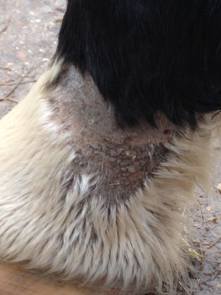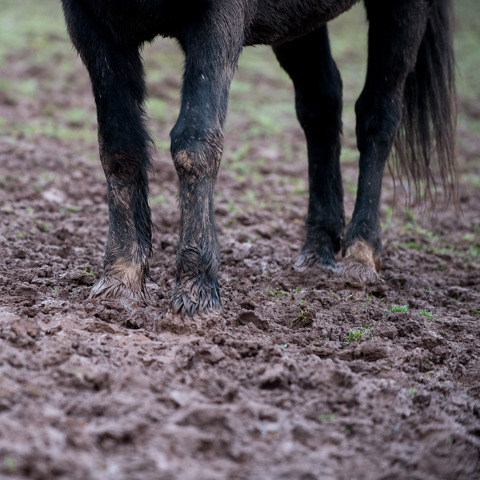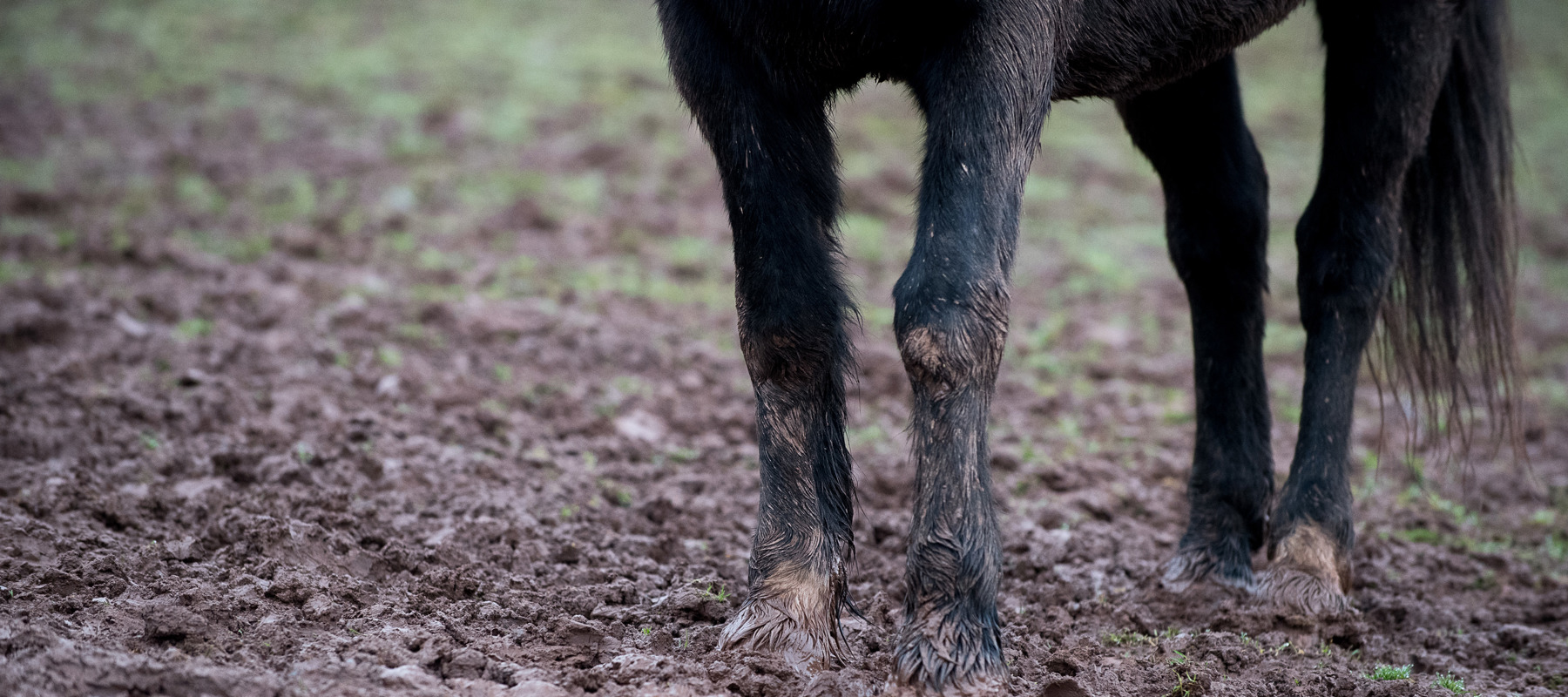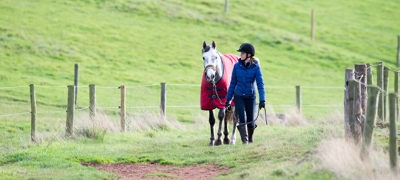What is mud fever in horses?
Mud fever in horses is a non-contagious skin condition (which means it doesn’t spread from one horse to another, or to people) that causes irritation to the horse’s lower legs. You may also hear it referred to as dermatitis, greasy heels and cracked heels.
Signs
Mud fever (sometimes known as mud rash) commonly forms on the pastern (between the fetlock and the hoof) and on the heel.
Common signs of mud fever include:
- Crusty scabs appearing on the heels or lower legs
- Broken and/or damaged skin
- Matted hair or patches of hair loss with raw skin underneath
- A creamy, white, yellow, or green discharge between the skin and the scabs
- Heat, pain and swelling in the lower limb
- In severe cases, lameness may also be seen.
Infections can develop underneath the scabs, and you may see swelling of the leg in severe cases. Mud fever can be painful, and the horse may not tolerate the area being touched.
To help make sure you spot any signs of mud fever straightaway, check your horse’s legs daily — it should be easier to manage if you catch it in the early stages.

Photo Credit: The Minster Equine Veterinary Clinic
Did you know?
Mud fever can also occur in other areas of the body, such as on the belly, and on the back and is known as rain scald.
What causes mud fever?
Mud fever is most often caused by bacteria and is common in the winter months. This is because the wet conditions cause the skin to soften and mud rubs against this softened skin causing damage to the surface where bacteria can enter.
Horses with thick feathers are more at risk of leg mites and you will see them stamp their legs because they’re very itchy. Extensive itching may break the skin and the area becomes susceptible to bacteria. If you suspect your horse has mites, speak to your vet for further advice.
Risk factors
There are several factors that may cause damage to your horse’s skin, leaving them susceptible to bacteria and therefore mud fever. These include:
- Standing in muddy or wet conditions for long periods.
- Standing in dirty bedding.
- Regularly washing the legs, especially if they’re not dried afterwards.
- Having broken or damaged skin due to a wound, such as an overreach injury.
- White legs as the pink skin under white markings is often more sensitive than dark skin.
- Thin skin such as Thoroughbreds or Arabs, which can be damaged more easily.
- Having a weakened immune system — which is usually secondary to another condition, such as Cushing’s Disease. Horses with a lowered immune system are less able to prevent and fight off infections, so are more prone to health conditions. If these horses suffer from mud fever, it can be more difficult to treat.
Mud fever treatment
It’s important to call your vet as soon as mud fever is suspected so they can give an accurate diagnosis and make sure treatment is tailored to meet your horse’s needs. Once your vet has made a diagnosis and recommended a treatment plan, they should be happy for you to manage the condition yourself. However, if your horse fails to respond to treatment, or the mud fever gets worse, get back in touch with your vet.
A general treatment plan could include:
- Bringing your horse in out of the muddy and wet conditions to keep their skin clean and dry where possible.
- Removing the scabs to help you gain easier access to the skin and to allow air to reach the area and aid healing. However, if you choose to do this proceed with caution as it can be very uncomfortable for your horse and sedation may be necessary. Any loose scabs may be gently removed, but scabs should not be forcibly removed unless advised by your vet.
- Cleaning the affected area at least twice a day using a mild disinfectant, such as dilute Hibiscrub, then rinsing with water and patting the leg dry with a clean towel.
- Applying stable bandages to dry legs can help keep them clean, provide support and reduce any potential swelling.
- If mites or a fungal infection have triggered the mud fever, individual treatment for these causes may be required.
If your horse has thick feathers you may need to carefully clip the hair from the lower leg to expose the skin to the air and make it easier for you to clean and treat. Severe mud fever may require repeat treatments and cream applied to the skin. Your vet will be able to advise on the best course of action and treatment plan. In more severe cases, a blood test may be required to identify an underlying disease. If the mud fever isn’t clearing up, a swab can also be taken to check for bacterial growth and sensitivity. This will help the vet decide if antibiotics are appropriate. Anti-inflammatories may be recommended by your vet depending on the clinical signs and overall health of your horse.
If left untreated mud fever can cause further complications such as cellulitis and even lymphangitis. These conditions are both bacterial infections in the lower leg which affect the blood vessels and lymphatic vessels often causing swelling and discomfort. Speak to your vet if you notice any swelling – the conditions can often affect one leg at a time.
How to prevent mud fever
There are many ways to reduce the risk of your horse developing mud fever, and they are all aimed at avoiding the underlying causes:
- Avoid leaving your horse standing in wet and muddy conditions for long periods of time; make sure they have somewhere dry to stand for at least part of the day.
- Adopt good grassland management by rotating fields to reduce poaching and put hardcore down in places where horses gather, such as gateways and water troughs. Fence off any particularly muddy areas.
- Avoid washing your horse’s legs when you bring them in from the field and instead wait until the mud is dry, then brush it off using a soft bristled brush. If you do wash your horse’s legs, dry them thoroughly afterwards using a clean, dry towel.
- Barrier creams can be used prior to turnout, to create a protective layer between the skin and the mud. However, make sure the skin is dry and clean prior to application, otherwise they can provide the perfect environment for bacteria to grow between the skin and the cream.
- There are boots available which are designed for turnout to prevent mud getting to your horse’s legs; but it’s important that they are well-fitting to avoid rubs and sores which may cause more of a problem.
- Treat any underlying conditions such as mites, fungal infections or wounds.
Written in conjunction with VetPartners, Katherine Hall BVSc MRCVS and Matt Swarbrick BVSc (Hons) CertAVP MRCVS. The Minster Equine Veterinary Clinic.




